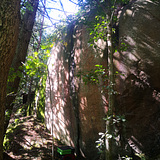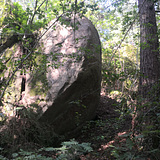A fantastically beautiful and accessible forest with nice trails that take you all the way to the walls and boulders.
There's something for everyone, from easy to difficult, low to high, sharp rock and less sharp rock. Pick your poison.
The area is under development, and the total number of boulders will likely be around 30-40.
Contact me (Simon Bengtsson), and I’ll be happy to show you the existing problems and the potential of the area.
How to get here with a bus
Take bus 37 to Assmundtorp and it's a 10 minute walk to the main area.
In the middle of Hisingen in Gothenburg, Skändlaberget rises like an island in the surrounding farmland. Long ago, it was also an island in an ancient sea. Numerous archaeological remains from various time periods show that the mountain has been used by people for thousands of years. Skändlaberget is located in one of Bohuslän’s richest areas in terms of ancient remains, with artifacts from every prehistoric period, including the Stone Age, Bronze Age, and Iron Age. At its highest point are two large Bronze Age cairns, and Viking-era graves and settlements are also found nearby.
Skändla village, believed to have medieval origins, is equally culturally significant. When Tuve became part of Sweden in the 13th century, Skändlaberget formed part of the northern border between Sweden and Norway. The largest Bronze Age cairn served as a boundary marker until 1658. Remarkably, Skändla village remained intact through the 19th-century land reforms, and the well-preserved Skändla Sörgård farmstead stands below the mountain. Just east of the village lies Skändla’s shell gravel bank, known for its rare flora due to the nutrient-rich soil.



